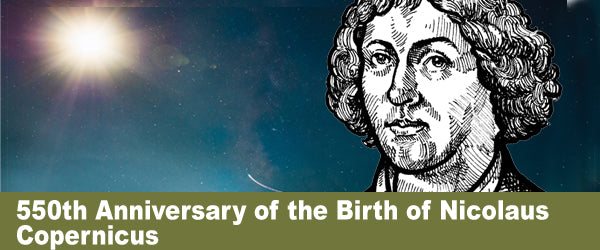
Posted by The Home School in the Woods Team on
By Sam Pak
This February, 2023, we are celebrating the 550th birthday of the father of modern astronomy, Nicolaus Copernicus!
Arguably one of the most important and revolutionizing scientists in history, Copernicus helped the world move away from the Ptolemaic perspective of the universe and posed the understanding that the earth actually revolves around the sun, not vice versa.
A hugely important breakthrough for multiple reasons, it transformed marine navigation and the efficiency of commerce, it better controlled calendar systems, and it validated certain applications of mathematics.
Let’s dive into the life of Nicolaus Copernicus and explore how he was such an extraordinary personality during the renaissance period in Europe.
His Roots
Copernicus was born on February 19, 1473, in the city of Toruń, in newly formed Royal Prussia. Not much is known about Copernicus’s early childhood other than it was believed that he was raised by his uncle after his father passed away in 1483.
Copernicus’s family was privileged with financial resources that allowed him to attend good schools and build a firm foundation for his academic career, which would prepare him for the scientific breakthrough he’s known for. He first studied painting and math and would eventually study medicine and law. His continual mastery of different subjects was what rounded him into the iconic depiction of what we would today call a “renaissance man.”
Despite his upbringing and exceptional intelligence, his lifestyle was very frugal, and he conducted his research with very limited, crude tools. He didn’t even have access to a telescope in his own makeshift laboratory!
So What Did Nicolaus Copernicus Discover?
Copernicus was instrumental in correcting the understanding of how the solar system works. Previously, the accepted understanding was geocentrism, which says that the earth sits at the center of the universe.
The older method was adopted by navigators as they endeavored to leverage the stars to pinpoint their whereabouts and their destination. The problem was that navigating this way relied more on experience and less on calculated models, which proved unreliable over time.
It was Copernicus who wanted to push mankind to rely on mathematics to understand the stars better. In 1543, he published his seminal work, “De revolutionibus orbium coelestium,” or “On the Revolutions of the Heavenly Spheres,” which would later prove wrong the popular belief that the universe revolved around the Earth.
The idea that he proposed was that the distance between an object and the sun contributes to the behavior of how it moves around the sun. This was very revolutionary for people to grasp at the time and defied the logic that the Earth was central.
His works contain seven axioms that include the earth orbiting the sun and the moon orbiting the earth. He also theorized that stars were actually much further away than we had currently understood at the time.
His thesis was initially rejected by contemporary scholars and the church, implying that his ideas were radical and unhelpful in knowing the universe any better than the understanding already shared by the majority of astronomers and scientists.
Ironically, he was later consulted by the Catholic church in 1582, somewhat begrudgingly, to help resolve the Lateran Council’s dilemma in reforming the solar year’s calendar, due to sacred holidays like Easter slipping up to ten days away from the designated calendar placement.
His Death and Legacy
Nicolaus Copernicus passed at the age of seventy on May 24th, 1543. He was buried in an unmarked grave beneath Frombork’s cathedral until he was later identified and reburied in a hero’s grave in 2010, when the world saw fit to commemorate him for his progressive ingenuity.
It would not be until the 17th century that the brilliant minds of Galileo and Kepler would harness the Copernican theory, iterate upon it, and deliver much more convincing arguments that suggested Copernicus was on the right track. One of the primary corrections that Galileo pointed out, contrary to Copernicus, was the theory that the Sun was at the center of the solar system, not the center of the universe.
Incorporating Copernicus Into Your Schooling
There are a variety of ways that Copernicus can be utilized as a learning topic in history. Whether you’re learning about the robust nature of renaissance men and women, exploring a focused unit on scientific figures of importance, or studying the influence of math in astronomy, Copernicus is relevant!
You can find a hands-on project portraying the heliocentric model compared to the geocentric model in our Renaissance and Reformation unit study. Whether you have a timeline already underway or are looking for a place to start with a brand new historical timeline, Copernicus can and should be included! He’s featured as a timeline figure in our Resurrection to Revolution historical figures pack and in our Science, Invention, and Mathematicians independent timeline set.

Hello, I would like to add little comment:
Copernicus was born in Poland. On March 6, 1454, there was a rebellion against the Teutonic Knights (later Ducal Prussia). After the uprising and the Thirteen Years’ War, Royal Prussia, also known as Polish Prussia, was reunited with Poland in 1466 (under the Second Peace of Toruń). Thus, Royal Prussia was at the time when Copernicus was born – 1473 – part of Poland. Toruń within the borders of the Republic of Poland was the Golden Age of Toruń. 1454-1793
Royal Prussia is the name of province, the name of the country was the Commonwealth of Poland or the Polish-Lithuanian Commonwealth. The Polish-Lithuanian Commonwealth was one of the largest countries in Europe, in 1637, after the wars with Moscow, it reached the largest area of over about 990 thousand km².